Transit Camp Westerbork (continued)
Ghost Letters (2)
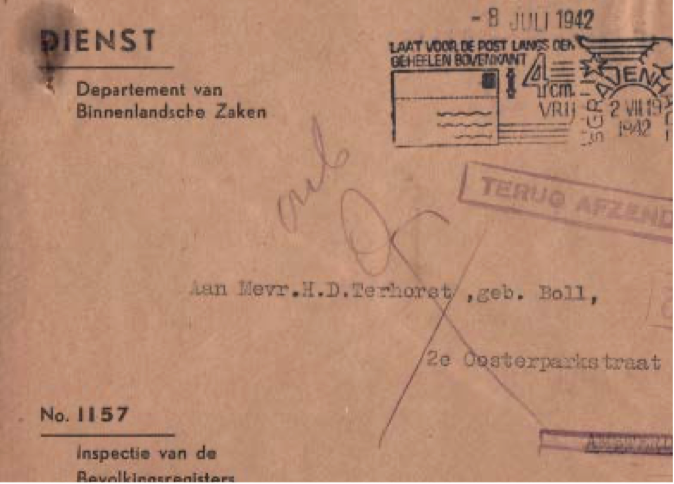
.png)
This Dienst service envelope (free of postage) from the Inspection of Population Registries in The Hague had been sent to Amsterdam on July 2, 1942. However, the addressee, Mrs. Terhorst-Boll no longer lived there. Delivery to a new address was also not successful. According to the official notation on the back, “new address in the area not known”. A pencil note reads “to Westerbork” but instead of the letter being forwarded it was instead returned to the sender. Helena Dimphina Terhorst-Boll, who was born in Rotterdam on August 15, 1903, survived the war and died in Amsterdam on May 4, 1980.
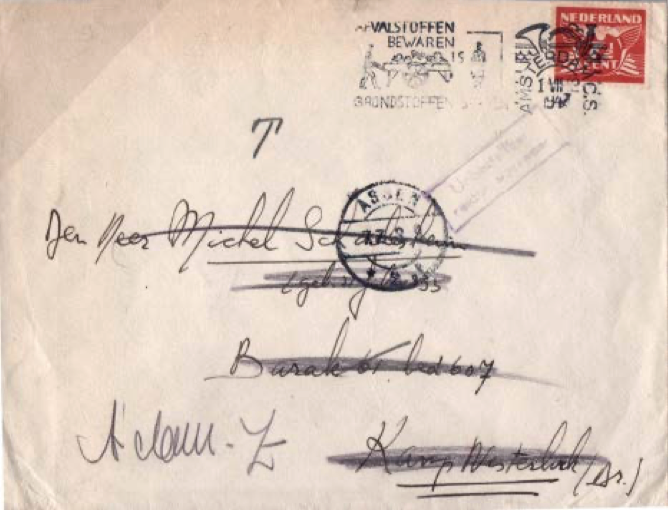
This cover dated July 1, 1943 was addressed to Amsterdam lawyer Michel Schorlesheim in “Barrack 65 bed 607 Kamp Westerbork”. It received a terug afzender, i.e. “return to sender” handstamp and the dreaded letter “T” and it was sent back on July 7, just five days after Schorlesheim had been murdered in Sobibor.
- Registration label from the St. Anthonies Breestraat post office in Amsterdam;
- Censorship Cologne Landsmann type CP3.3.1 (from October 1941 to September 1942); Postmarked Cracow, August 26, 1942;
- The “Einschreiben” (registered) handstamp was struck in Cracow to alert processors to the card’s special status;
- The label “Abgereist/ohne Angabe der Adresse” (departed without leaving address) in German, Polish, and French;
- The ominous handstamp “Verzogen!/Anschrift unbekannt” (moved, forwarding address unknown); and “Zuruck” (return) in manuscript.
%2C%20August%2021%2C%201942.png)
This card was sent to Aron Wurzel by his father, Abraham Wurzel, a Jew born in Srczuczin, Poland, on October 2, 1897. He lived at Sint Antoniebreestraat 41ll, in the Jewish section in the center of Amsterdam. Wurzel was on the train that left Westerbork, July 20, 1943, and was killed in Sobibor three days later.
Ghost Letters (3)
%2C%20April%2018%2C%201942.png)
%2C%20April%2018%2C%201942-2.png)
Postcard from Camp Westerbork, Barracks 49 to Leipzig. The card was taken to the camp post office and then to the nearby town of Assen. There it was processed and forwarded to Cologne for censoring (red handstamp).
Circular P. 1512 of December 24, 1941, announced that the postcard tariff to Germany (and some satellites) was reduced to 5 cents effective January 1, 1942. Landsmann type CP3.4.1 red censorship marking in Cologne.
I do not know the cause of all the aliments that are hurting me… in my right arm and hand I have a nerve inflammation…
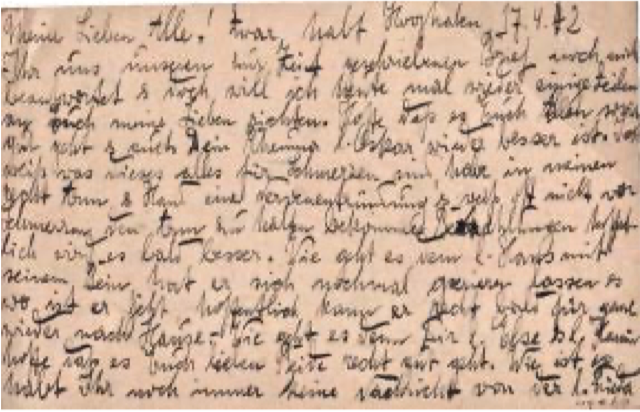
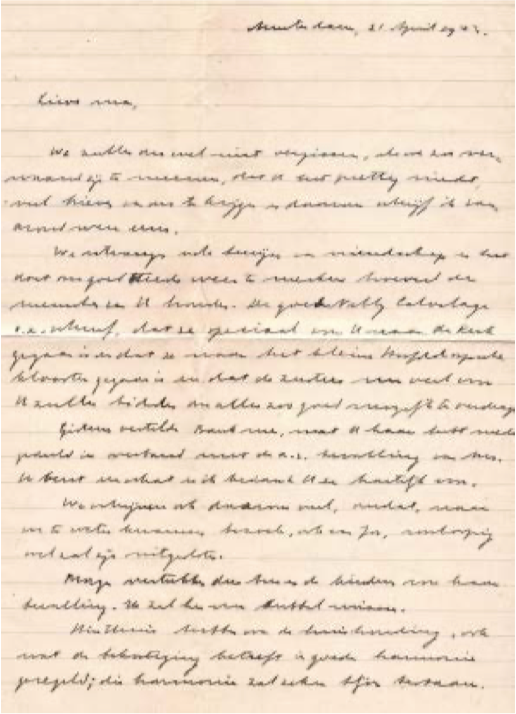
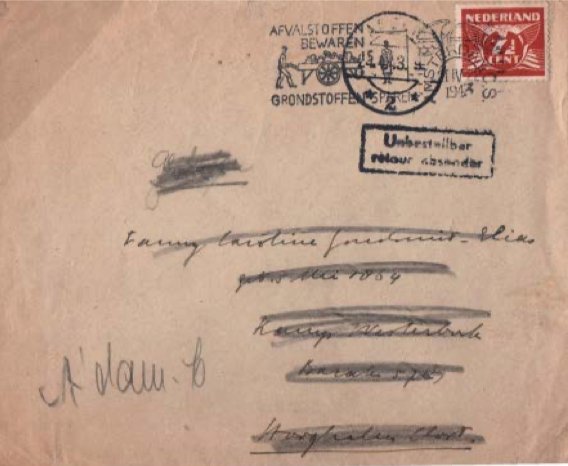
On April 21, 1943, Jopie Goldsmit sent a letter to her mother, Mrs. Goudsmit-Elias, who was interned at Westerbork. The letter was returned when it was realized at the camp post office that letter could not be delivered. Creation of a special handstamp had eliminated the need for the manuscript notation “terug afzender” (return sender) and the envelope received the right-angled handstamp “Unbestellbar / retour absender” (undeliverable/return to sender) as well as the long-bar stamp “Assen 2”.
In pencil the word “gestorben” (died) is written on the envelope, but this was crossed out later. When the letter arrived, Mrs. Goudsmit-Elias, age 78, was no longer alive. She had committed suicide the day before.
German Concentration Camp Mail
Theresienstadt / Terezin
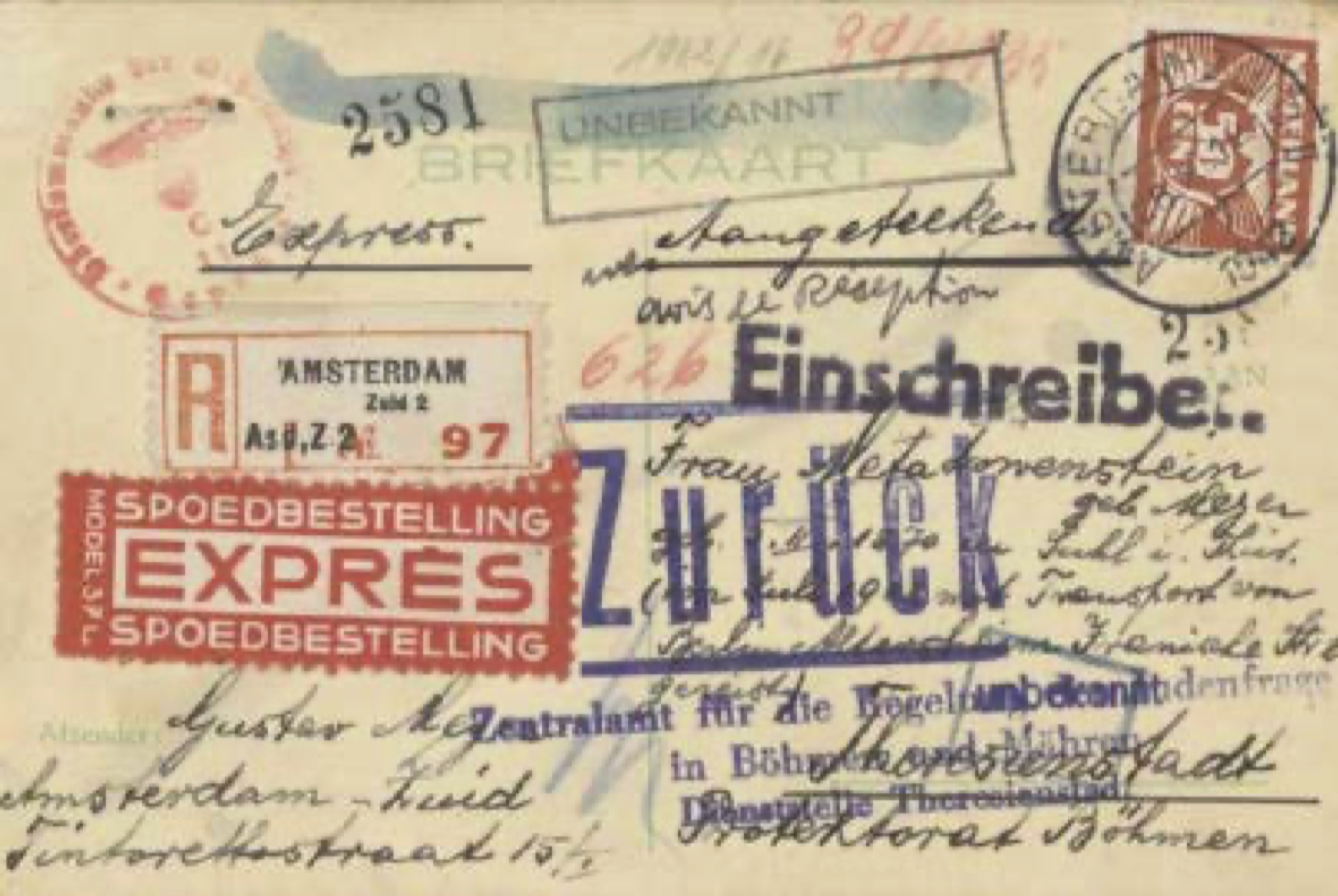
The sender of the postcard, Gustav Meyer in Amsterdam, had done everything possible to ensure that it was delivered in Theresienstadt. Not only was it registered with confirmation of delivery requested, but it was also sent by express service.
The name of the organization returning the card speaks volumes: Zentralamt für die Regelung der Judenfrage in Bohmen und Mahren /Dienststelle Theresienstadt, Central Office for Settling the Jewish Problem in Bohemia and Moravia, Field Office Theresienstadt. It is a direct reference to the subject of the Wannsee Conference held on January 20, 1942.
Meta Lowenstien-Meyer, the addressee, had been taken to Theresienstadt on July 14, 1942 and then to Treblinka where she was killed. The sender, Gustav Meyer, and his wife Margarethe were both killed in Auschwitz on August 27, 1943.
- Red censorship marking in Cologne (Landsmann type CP3.4.1) - Red pencil control markings;
- Blue chemical stripe;
- Handstamps UNBEKANNT ZURÜCK (return).
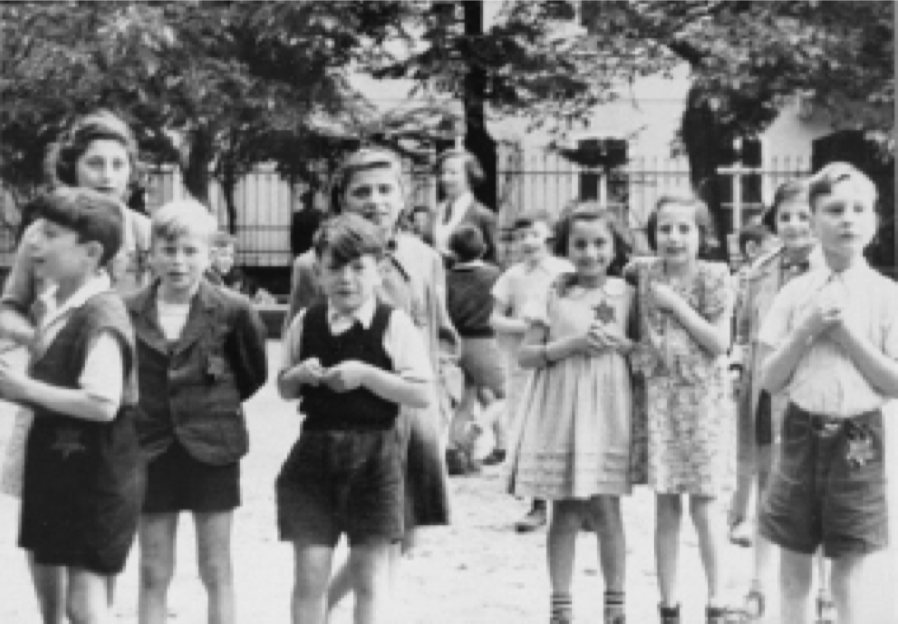
In November 1941, Adolf Eichmann selected the village of Terezin in the Protectorate of Bohemia and Moravia (formerly Czechoslovakia) to be a Jewish ghetto. Residents were ordered to leave by June 30, 1942. Theresienstadt housed prominent Jewish notables but also functioned as a transit camp for deportations to Auschwitz and Treblinka. It also served as a show settlement where organizations like the Red Cross carried out inspections. The Nazis accelerated deportations and beautified the ghetto before each visit, but once the inspectors had left, deportations resumed. Of the 4,897 Dutch Jews who were interned at Theresienstadt, 1,225 survived.
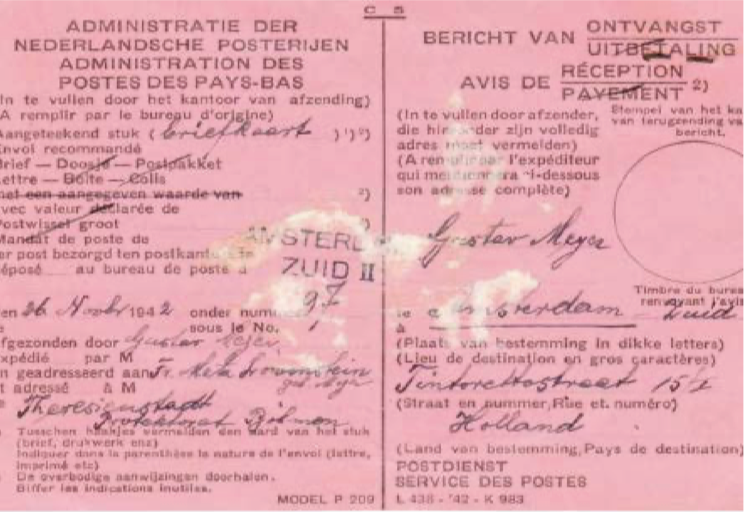

Buchenwald / Auschwitz
Buchenwald Camp was created on August 6, 1937. It was located in Weimar, known for its cultural heritage and importance in German history. Until 1944, the camp was for male prisoners, and at one time the population reached 238,000. When it was liberated by the Third US Army Division on April 11, 1945, the prisoners still numbered 80,000.
Auschwitz, also known as Auschwitz /Birkenau, is the name in German for the Polish city Oświęcim located about 40 miles west of Kraków. Opened in 1940, it was the largest of the Nazi death camps. Historians estimate that about 1.1 million people perished in Auschwitz during the 5 years of its existence, the majority of which (around 1 million) were Jews.
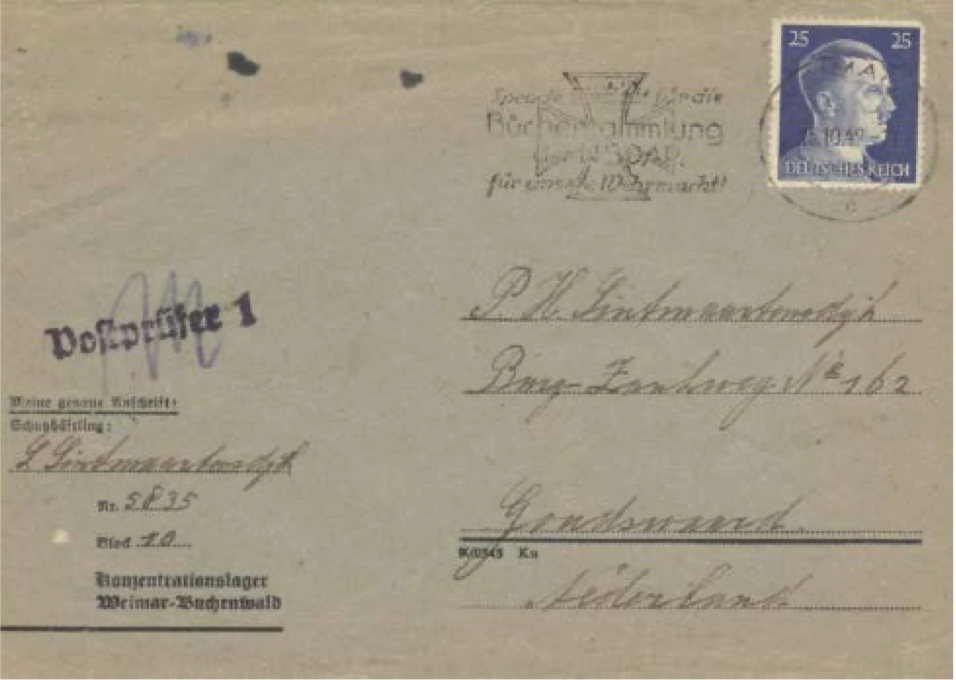
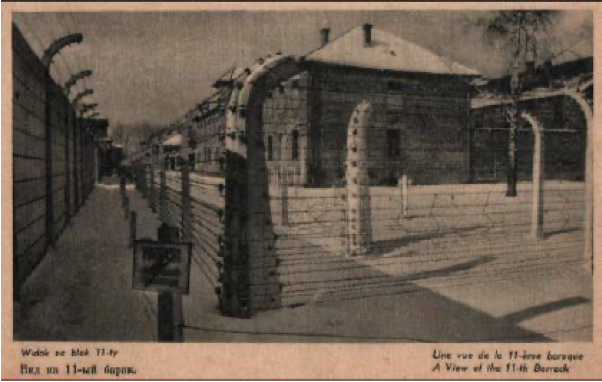
%20%E2%80%93%20Apeldoorn%2C%20August%2012%2C%201943.png)
%20%E2%80%93%20Apeldoorn%2C%20August%2012%2C%201943-2.png)
Registered express letter from a construction manager at I.G. Farbenindustrie A.G. at Auschwitz. The Farben work force consisted of slave labor from Auschwitz, leased to the company by the SS. One of the Farben subsidiaries produced Zyklon B, the gas that was used to kill over one million people in the Auschwitz gas chambers.